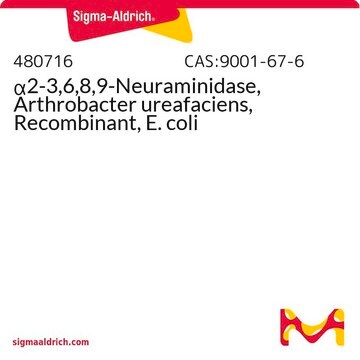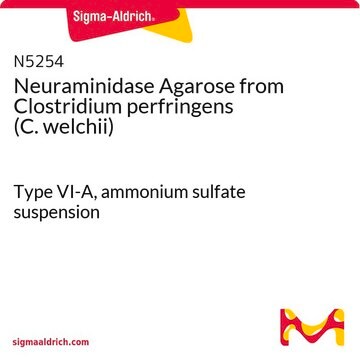10269611001
Roche
Neuraminidase (Sialidase)
from Arthrobacter ureafaciens
Synonym(s):
PCR, taq
Sign Into View Organizational & Contract Pricing
All Photos(1)
About This Item
Recommended Products
biological source
bacterial (Arthrobacter ureafaciens)
Quality Level
form
solution
specific activity
~25 units/mg protein
packaging
pkg of 1 U (100 μl)
manufacturer/tradename
Roche
optimum pH
5.0-5.5
storage temp.
2-8°C
General description
Neuraminidase hydrolyzes terminal N- or O-acylneuraminic acids which are α2,3-, α2,6-, or α2,8-linked (rate: α2,6 > α2,3 > α2,8) to oligosaccharides, polysaccharides, mucopolysaccharides, glycoproteins, and glycolipids. Noteworthy, for the hydrolysis of glycolipids, the presence of a detergent is necessary. Because of the broad substrate specificity, the enzyme is very well suited for the complete removal of sialic acids from glycoconjugates of a wide variety of biological materials.
Specificity
Cleaves terminal sialic-acid residues that are α2,3-, α2,6-, or α2,8-linked to Gal, GlcNAc, GalNAc, AcNeu, GlcNeu, oligosaccharides, glycolipids, or glycoproteins. Relative rate of cleavage is α2,6 >α2,3 >α2,8, determined on bonds in tri- and tetrasaccharides.
Application
- cell surface lectin array analysis.
- hemagglutination assays.
- cell adhesion assay.
For the hydrolysis of glycolipids, the presence of a detergent is necessary. Because of the broad substrate specificity, the enzyme is very well suited for the complete removal of sialic acids from glycoconjugates of a wide variety of biological materials.
Neuraminidase has been used for the:
- detection of the cell surface glycosylations in human anaplastic large cell lymphoma cells
- release of sialic acid from cells
- antibody-overlay lectin microarray
Physical properties
This product is a mixture of isoenzymes (L, M1, M2 and S) with the following molecular weight values: ~ 52 kDa, 66 kDa and 88 kDa.
Physical form
Solution in 10 mM sodium phosphate, 0.1% Micr-O-Protect (w/v), 0.25 mg/ml bovine serum albumin, pH 7
Preparation Note
Working concentration: Enzyme/substrate ratio should be in the range of 0.04 U/25-80 μg.
Other Notes
For life science research only. Not for use in diagnostic procedures.
signalword
Warning
hcodes
Hazard Classifications
Skin Sens. 1
wgk_germany
nwg
flash_point_f
does not flash
flash_point_c
does not flash
Choose from one of the most recent versions:
Already Own This Product?
Find documentation for the products that you have recently purchased in the Document Library.
Customers Also Viewed
Charting the Proteoform Landscape of Serum Proteins in Individual Donors by High-Resolution Native Mass Spectrometry.
Cramer, et al.
Analytical Chemistry, 94, 12732-12741 (2022)
Tomonori Kaifu et al.
The Journal of experimental medicine, 218(12) (2021-11-25)
Dendritic cell immunoreceptor (DCIR) is a C-type lectin receptor with a carbohydrate recognition domain and an immunoreceptor tyrosine-based inhibitory motif. Previously, we showed that Dcir-/- mice spontaneously develop autoimmune enthesitis and sialadenitis, and also develop metabolic bone abnormalities. However, the
Cellular entry of the porcine epidemic diarrhea virus
Li W, et al.
Virus Research, 226, 117-127 (2016)
Sialylation by ??galactoside ??2,6?sialyltransferase and N?glycans regulate cell adhesion and invasion in human anaplastic large cell lymphoma
Suzuki O, et al.
International Journal of Oncology, 46(3), 973-980 (2015)
Jiaqi Wu et al.
BioTechniques, 68(2), 85-90 (2020-01-16)
Carbohydrate-deficient transferrin (CDT) is a reliable biomarker for chronic alcohol abuse. We developed a method for CDT analysis by capillary isoelectric focusing, followed by immunodetection directly in the capillary, in an automated fashion and on a single platform (Peggy Sue™;
Protocols
Neuraminidase can be used to cleave sialic acids from proteins. In this protocol, the enzyme from Vibrio cholerae is used on fixed cells.
Our team of scientists has experience in all areas of research including Life Science, Material Science, Chemical Synthesis, Chromatography, Analytical and many others.
Contact Technical Service







